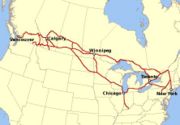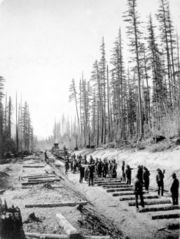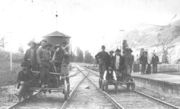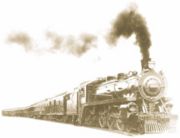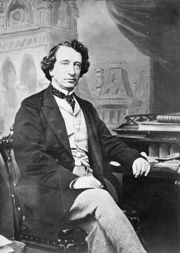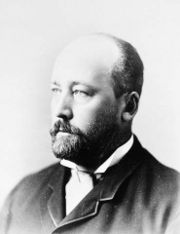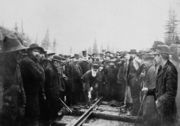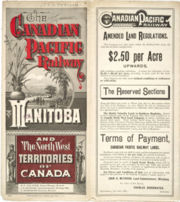加拿大太平洋铁路公司
出自 MBA智库百科(https://wiki.mbalib.com/)
目录 |
加拿大太平洋铁路(The Canadian Pacific Railway,CPR或加太铁路)在自治领建立之初的一个时代里,既是整个加拿大西部开拓和发展的主导性因素,又是对抗美国扩张势力,支持麦克唐纳国家政策的重要力量。它成功地用一条大锁链把东西加拿大紧紧地连在一起,实现了麦克唐纳国家政策的梦想,并置身于西加拿大发展的各项事业之中,为西部的开拓做出了重要的贡献。
加拿大太平洋铁路是加拿大的一级铁路之一,由加拿大太平洋铁路公司营运。其网络横跨西部温哥华至东部蒙特利尔,并设有跨境路线,通往美国的明尼阿波利斯、芝加哥、纽约市等大型城市。公司总部设于艾伯塔省卡尔加里。
加拿大太平洋铁路公司修建连接全国的铁路仅仅是开始。100多年来,加太铁路更是担负着政府和公众的重托,以及管理这个庞大帝国所面对的种种挑战,虽有曲折,但隧道的尽头定有光明。
自从苏格兰移民、蒙特利尔银行董事长乔治-史狄芬1881年创建加太铁路公司以来,加太铁路可谓历尽千辛。公众的挑剔,甚至吹毛求疵与加太铁路的影响相比显得无足轻重。确实如此,加太铁路公司的第一个工程——一条横贯加国、连接西部口岸的1900英里长铁路,工期10年,当时被反对派讥讽为耗资巨大的荒唐行为。然而,当加太铁路公司执行总裁唐纳德-史密斯举起铁锤,钉下那枚著名的金质“最后道钉”的一刻,加太铁路公司创造了两项奇迹:工程提前五年多竣工;在经济萧条期内酬款1.645亿加元。
那神话般的“最后道钉”似乎冲淡了加太铁路公司征服的艰难困苦和政府的不友善关照。曾有人认为,加太铁路公司同意修建横跨加拿大的铁路,并因此得到联邦政府的2500万加元补贴,2500万英亩土地和710英里长铁轨是窃取国库。不过这些人的确低估了加太铁路公司。加拿大俾诗省前省长曾经评论说:只有充满冒险精神的公司才会在荒漠中建铁路,虽然他们得到了大片的土地,但同时也承担了巨大的风险。 19世纪末期,加太铁路公司一度得到执政保守党政府的优待,但好景不长。自由党上台后,政府开始向加太铁路公司的竞争对手发放特许权。加太铁路公司得以在这个资本密集型行业中取胜,并基本未伤元气地渡过20世纪30年代的大萧条,除得幸于其规模庞大外,主要应归功于它杰出的经营管理。
除经营铁路外,加太铁路公司的章程中还包括可以经营电报、电话、码头,以及任何“必要和有用”的业务。在加太铁路公司的发展史中,曾多次不得不应付来自政府的竞争。1942年,加太铁路公司在获得航空经营权的23年后,加拿大太平洋航空公司(Canadian Pacific Air Lines)的航班飞上了蓝天。由于加拿大航空公司(Air Canada)得到了政府的支持,并获许经营利润丰厚的加东和国际航线,令加太航空公司的财务状况长期处于无盈利状态。但加太铁路公司一直努力经营加太航空公司,直到1987年以3亿加元价格将它卖给西太平洋航空公司(Pacific Western Airlines)。1981年,加太铁路公司成立百年之时,该公司已发展为一个强大的联合体,业务含括所有主要的运输业、自然资源业和房地产业,年收入达126亿加元,足以同时买进加拿大通用汽车、帝国石油和辛普森-西尔司这样的大公司。与其它大型联合公司不同的是,加太铁路公司以商家对商家经营为主,很少直接接触顾客。从1923年至1985年,加太铁公司不可思议地连续62年未出现亏损。
加太铁路公司的成功,部分原因是将日常管理交予子公司,同时提供远期规划和财务支持。这种分散经营的管理方式使子公司有更大的自主权和更明确的目标,为 2001年加太铁路公司的五家子公司成功分离,独立上市经营奠定了基础。分离后的五家公司中,最强大的似乎仍是加太铁路公司——老加太铁路公司的股票每股现值70多加元,比2001年2月12日宣布分离前升值了37%。
加拿大是一个多民族的移民国家,历史并不悠久。然而,像跨北美大陆的加拿大太平洋铁路(CPR)100多年来为这个年轻国家的建立和建设所做出的贡献,这条铁路所沉蕴涵的文化价值和历史价值,已经成为加拿大宝贵的文化遗产。
1、CPR的缘由——建设和统一一个新的国家
1867年7月1日由英国在北美大陆东部的四个省组成联邦,建立了一个新的国家加拿大。以后又有一些省加入。1871年位于西海岸的英属哥伦比亚 (B.C.)省(简称卑诗省)被诱惑加入联邦。其条件是在10年内建成跨大陆铁路,将其与加拿大东部联成一体。首任总理Sir John A. MacDonld决心“建设太平洋铁路以统一这个国家”。这就是当时建造太平洋铁路的缘由。
2、初期的天折——“太平洋丑闻”
太平洋铁路项目一开始就不顺利。J.A. MaCDonld的保守党政府要求由一个私人公司来建造这条铁路。需要拨出3000万加元的补贴和留出5000万英亩土地才能让一个私人企业来完成这项工程。一个实业家和运输业巨头Hugh Allan是当时加拿大最富有的人。
联邦自由党人发现,他曾经在1872年大选中赞助过各式各样的保守党人共计约36万加元,以此来确保得到这项铁路建设合同,使其能控制这条跨大陆铁路,以便垄断加拿大大陆和东西海岸的交通。这个被称为“太平洋丑闻”事件的曝光迫使该合同于1873年重新签订,并导致保守党政府的倒台。
自由党人在新一轮选举中获胜。这届政府对铁路建设的热情就差多了,并认为可以将其作为公共工程来建设。1875年6月1日Judge Norman在Fort William附近主持了破土动工仪式,标志着加拿大太平洋铁路建设的开始。但是,到1878年该政府换届时只在中部省份安大略和曼尼托巴开始建设了一小段铁路线。
3、艰难的开拓——维护统一的动力和华裔劳工的贡献
此时,卑诗省眼看10年期限很快即至,而政治家们关于把跨大陆铁路修到该省的承诺将无法如期兑现。于是,他们威胁说要退出联邦。J.A. MacDonal总理1878年重新执政,在保守党人的压力和支持下,他不得不做一些实质性的事情,向卑诗省显示铁路将要修到他们省内。这届政府与一个美国人Andrew Onderdonk签订了合同,开始从西海岸沿Fraser河向上游修筑铁路线。
这个美国人采用了“美国建造方法”——尽可能省钱,一味地追求利润和进度。他的方法就是使用中国劳工。一些中国商人在卑诗省设立了劳工代理事务所,招收中国同胞去当筑路工。沿着Fraser河谷陡崖的这一段线路特别艰难,615公里长的路段用了1.5万名劳工7年的时间才修通,其中9千人是华裔。不仅是地形、地质上的难度,而且施工方法也十分危险。
为了省钱,承包商不采用强力炸药,而让劳工们用便宜但很不稳定的硝化甘油来进行爆破作业。没有确切的伤亡报告。目击者和报纸公布了可怕的照片,估计有700至800人死于建造这段政府合同的铁路,大约占劳工总人数的5-9%,其中大部分是中国人。加拿大政府官员至今在每年国庆致辞中往往还会回顾华裔在这段建国历史中的贡献。
4、CPR公司成立——千军易得一将难求
经董事会成员推荐,Van Horne承担起了CPR总经理的职位。他是美国正走红的工程界明星。CPR以1.5万加元年薪把他从美国Milwankee道路项目上挖了过来,负责监管该跨大陆铁路穿过草原和山脉的最艰难路段的建设。他如此高薪的2/3是隐藏在施工费用里的。他夸口其第一年任期(1882年)内将建成800公里铁路干线。但天不作美,洪水迫使施工季节推迟。不过,到该施工季节末,他还是完成了673公里干线和177公里支线的铺轨任务,使太平洋铁路似乎看到了胜利的曙光。
5、探索线路、筹集资金——网罗人才同舟共济
CPR在这个时期还探索了比较靠南的替代线路,来穿越落基山脉,并答应给发现可行线路者5000加元的奖金。许多人为寻找新的线路作出了贡献。其中之一Major A. B. Rogers发现了一条东部通过山脉的路径,后来被称为罗杰斯隘口(Rogers Pass)。他于是得到一张5000元奖金的支票。但他没有去兑现,而是镶在镜框里挂在墙上。总经理Van Horne为了让他把支票兑现,以便结帐,不得不以一块金表为诱饵,将这张支票从墙上换下来。
在工程初期资金流始终是一个难题。施工费用支出巨大,而从交通流量上取得回报却很少。Van Home约请在美国Milwankee的贸易金融奇才Thomas G. Shaughnessy来帮助他解决这个问题。Thomas于1882年受雇CPR,任采购总代理,后来接替Van Horne掌管公司。在此其间他争取到了6亿加元的投资,公司得到了扩展和提升,直到第一次世界大战爆发。
6、度过惨淡岁月——借助政治因素和发行国际债券
在进入20世纪初的这段时期,CPR渡过了好几个非常困难的沟坎。1883年在铺设Calgary东段路轨时,几乎与当地土著人发生冲突。因为铁路要跨越他们的Gleichen自然保护区。最终公司带着政府同意给土著人附加土地以补偿铁路占用的消息,与土著领袖一起才平息了这场危机。
在东西段铁路将要接通前的时期,CPR面临了她历史上最惨淡的境遇。苏必利尔湖的北岸、Rockies和Selkks是该铁路使用私人资金建造部分中最艰难的区段。某些路段每公里造价接近50万加元。1885年初,CPR几乎频临破产。公司既没钱还债,也无钱购置新的施工材料和设备,甚至连优先股的红利和工资都发不出来。最终有两个人“拯救”了这条铁路。
一个人是Louis Riel,从第一次叛乱流亡国外,1885年又回到美国领导第二次暴动。美国军队从东部运送到西部,全是通过加拿大接近完成的太平洋铁路干线,只用了几个星期就平息了这次动乱。而1869年军队花了几个月的艰难旅程,从东向西跨越北美大陆,才平息第一次叛乱。Louis Riel的所作所为,使加拿大联邦政府明白了CPR对国家安全的重要意义,并同意确保给予CPR尚未支付的贷款。
另一个人是Revelstoke勋爵,伦敦一家著名金融公司的主管。他同意以92.5分的价格购买每一元的CPR债券,使其再次度过了财务危机。
1885年11月7日CPR创始人之一Donald Smith在卑诗省的Craigellachie砸下了“最后一颗道钉”,把太平洋沿岸与加拿大的心脏地区蒙特利尔连接了起来,标志着此跨大陆铁路的建成。CPR负责人Van Horne说“这是一个终点,也是一个起点”。1886年6月28日第一列跨大陆列车自蒙特利尔和多伦多开往东部的默帝(Moody)港。从此以后的三年内一切都很顺利,CPR又重新开始向股东分红。铁路有力地巩固和增进了国家的联合和团结,并开始了向西部的移民。铁路把人和物资源源不断地送到新的疆土,使沿线的城镇和工业逐渐成长起来。
7、公司发展与战争考验——国家利益高于公司利益
1889年铁路实现了从东海岸到西海岸的全线通车。不仅如此,CPR还开拓了多种经营业务,包括房地产、跨大陆电报线路的架设和经营、自己建造蒸汽机车和车厢,以及在北美五大湖和两大洋的海运业务。公司总经理Van Horne建议在落基山脉建立国家公园,从而CPR开始经营旅馆和旅游业。CPR还因一次偶然的钻井取水事故在阿尔德森和阿尔伯塔大草原上发现了天然气,并用于车站和辅助建筑的取暖和动力。 第二次世界大战期间,Edwoard W. Beatty主持CPR度过了历史上又一个困难的时期。其一是与加拿大国家铁路公司(CNR)的商业竞争。其二是Beatty把整个公司的交通网络投入了支持战争的部署。在陆上,CPR运送了3.07亿吨的物资,8600万人员,其中包括15万士兵;在海上,22艘CPR的船只开赴前线,其中12艘被击沉;在空中,CPR破天荒地开辟了“大西洋桥”,把轰炸机用跨洋轮渡送到英国。到1945年为止,CPR有33127名员工服务于两次世界大战,其中 1774人阵亡。一个私人企业仍然把国家利益置于首位。
8、近50年的演变——股份本土化和回归铁路主业
20世纪50年代,公司把大部分股份收回到加拿大本国的股东手中,并大大开拓了非运输的产业部门。1962年成立了加拿大太平洋投资公司。
经过100多年的经营,到1986年加拿大太平洋公司成为加拿大第二大公司,年收入150亿加元,资产177亿加元,将近10万员工。1990年CPR扩展她的铁路网络,全部控制了美国中西部的Soo线。 1991年CPR并购了D&H铁路公司,使其网络通达美国东北部港口城市。
2001年10月3日,加拿大太平洋公司分解为五家公司——铁路、海运、旅馆、煤炭和能源公司。其能源公司与阿尔伯塔能源公司合并为EnCana公司。铁路公司CPR仍然经营她的主业。此时,CPR早已由客运为主转变为货运为主。
目前,CPR的加拿大网络包括从蒙特利尔到温哥华的高密度干线和许多汇入支线。她的美国部分网络延伸到中西部和东北部的工业区,可以无转换地直达芝加哥、费城和纽约,其铁路网络总长22536公里。
9、历史遗址和铁路博物馆——加拿大人心中的CPR
除了土著印第安人的历史和早期欧洲人到北美大陆的探险外,加拿大太平洋铁路的历程几乎贯穿了这个年轻国家的整个历史。作家将其写入自己的著作,详细记载和描述了她的历史事实和曲折故事,并广为流传。
铁路经过的一些省份建立了铁路博物馆。在阿尔伯塔省的爱德蒙顿市,还保留了一段2.5公里原来的铁路线路作为历史遗址,并改建为城市铁路供游览观光。该市在老城区Strathcona复制了最初的木结构铁路车站原型,作为一个民办的博物馆。在馆里还保留着当时点煤油的信号灯和轧轧出声的手摇电报机等文物。
1867年当加拿大刚刚建国时,人们不可能预见到100多年来这个跨北美大陆的太平洋铁路会遭遇的全部坎坷和兴旺,也不可能评估出她后来对这个国家和人们所体现的全部价值。
The Canadian Pacific Railway (CPR; AAR reporting marks CP, CPAA, CPI), known as CP Rail between 1968 and 1996, is a Canadian Class I railway operated by Canadian Pacific Railway Limited. Its rail network stretches from Vancouver to Montreal, and also serves major cities in the United States such as Minneapolis, Chicago, and New York City. Its headquarters are in Calgary, Alberta.
The railway was originally built between eastern Canada and British Columbia between 1881 and 1885 (connecting with Ottawa Valley and Georgian Bay area lines built earlier), fulfilling a promise extended to British Columbia when it entered Confederation in 1871. It was Canada's first transcontinental railway. Now primarily a freight railway, the CPR was for decades the only practical means of long distance passenger transport in most regions of Canada, and was instrumental in the settlement and development of Western Canada. Its primary passenger services were eliminated in 1986 after being assumed by VIA Rail Canada in 1978. A beaver was chosen as the railway's logo because it is one of the national symbols of Canada and represents the hardworking character of the company. The object of both praise and damnation for over 120 years, the CPR remains an indisputable icon of Canadian nationalism.
- Before the Canadian Pacific Railway, 1871-1881
Canada's very existence depended on the successful completion of a major civil engineering project, the creation of a transcontinental railway. Creation of the Canadian Pacific Railway was a task originally undertaken for a combination of reasons by the Conservative government of prime minister Sir John A. Macdonald. British Columbia had insisted upon a national railway as a condition for joining the Confederation of Canada. The government thus agreed to build a railway linking the Pacific province to the eastern provinces within ten years of July 20, 1871. Macdonald also saw it as essential to the creation of a unified Canadian nation that would stretch across the continent. Moreover, manufacturing interests in Quebec and Ontario desired access to sources of raw materials and markets in Canada's west.
The first obstacle to its construction was economic. The logical route for a railway serving Western Canada would be to go through the American Midwest and the city of Chicago, Illinois. In addition to the obvious difficulty of building a railroad through the Canadian Rockies, an entirely Canadian route would require crossing 1,600 km (1,000 miles) of rugged terrain of the barren Canadian Shield and muskeg of Northern Ontario. To ensure this routing, the government offered huge incentives including vast grants of land in Western Canada.
In 1872, Sir John A. Macdonald and other high-ranking politicians, swayed by bribes in the so-called Pacific Scandal, granted federal contracts to Hugh Allan's "Canada Pacific Railway Company" (which was unrelated to the current company) and to the Inter-Ocean Railway Company. Because of this scandal, the Conservative party was removed from office in 1873. The new Liberal prime minister, Alexander Mackenzie, began construction of segments of the railway as a public enterprise under the supervision of the Department of Public Works. The Thunder Bay branch linking Lake Superior to Winnipeg was commenced in 1875. Progress was discouragingly slow because of the lack of public money. With Sir John A. Macdonald's return to power on October 16, 1878, a more aggressive construction policy was adopted. Macdonald confirmed that Port Moody would be the terminus of the transcontinental railway, and announced that the railway would follow the Fraser and Thompson rivers between Port Moody and Kamloops. In 1879, the federal government floated bonds in London and called for tenders to construct the 206 km (128 mile) section of the railway from Yale, British Columbia to Savona's Ferry on Kamloops Lake. The contract was awarded to Andrew Onderdonk, whose men started work on May 15, 1880. After the completion of that section, Onderdonk received contracts to build between Yale and Port Moody, and between Savona's Ferry and Eagle Pass.
On October 21, 1880, a new syndicate, unrelated to Hugh Allan's, signed a contract with the Macdonald government. They agreed to build the railway in exchange for $25,000,000 (approximately $625,000,000 in modern Canadian dollars) in credit from the Canadian government and a grant of 25,000,000 acres (100,000 km²) of land. The government transferred to the new company those sections of the railway it had constructed under government ownership. The government also defrayed surveying costs and exempted the railway from property taxes for 20 years. The Montreal-based syndicate officially comprised five men: George Stephen, James J. Hill, Duncan McIntyre, Richard B. Angus, and John Stewart Kennedy. Donald A. Smith and Norman Kittson were unofficial silent partners with a significant financial interest. On February 15, 1881, legislation confirming the contract received royal assent, and the Canadian Pacific Railway Company was formally incorporated the next day.
- Building the railway, 1881-1885
It was assumed that the railway would travel through the rich "Fertile Belt" of the North Saskatchewan River valley and cross the Rocky Mountains via the Yellowhead Pass, a route advocated by Sir Sandford Fleming based on a decade of work. However, the CPR quickly discarded this plan in favour of a more southerly route across the arid Palliser's Triangle in Saskatchewan and through Kicking Horse Pass over the Field Hill. This route was more direct and closer to the American border, making it easier for the CPR to keep American railways from encroaching on the Canadian market. However, this route also had several disadvantages.
One consequence was that the CPR would need to find a route through the Selkirk Mountains, as at the time it was not known whether a route even existed. The job of finding a pass was assigned to a surveyor named Major Albert Bowman Rogers. The CPR promised him a cheque for $5,000 and that the pass would be named in his honour. Rogers became obsessed with finding the pass that would immortalize his name. He found the pass on May 29, 1881, and true to its word, the CPR named the pass "Rogers Pass" and gave him the cheque. This however, he at first refused to cash, preferring to frame it, and saying he did not do it for the money. He later agreed to cash it with the promise of an engraved watch.
Another obstacle was that the proposed route crossed land controlled by the Blackfoot First Nation. This difficulty was overcome when the missionary Father Albert Lacombe persuaded the Blackfoot chief Crowfoot that construction of the railway was inevitable. In return for his assent, Crowfoot was famously rewarded with a lifetime pass to ride the CPR. A more lasting consequence of the choice of route was that, unlike the one proposed by Fleming, the land surrounding the railway often proved too arid for successful agriculture. The CPR may have placed too much reliance on a report from naturalist John Macoun, who had crossed the prairies at a time of very high rainfall and had reported that the area was fertile.
The greatest disadvantage of the route was in Kicking Horse Pass. In the first 6 km (3.7 miles) west of the 1,625 metre (5,330 ft) high summit, the Kicking Horse River drops 350 metres (1,150 ft). The steep drop would force the cash-strapped CPR to build a 7 km (4.5 mile) long stretch of track with a very steep 4.5% gradient once it reached the pass in 1884. This was over four times the maximum gradient recommended for railways of this era, and even modern railways rarely exceed a 2% gradient. However, this route was far more direct than one through the Yellowhead Pass, and saved hours for both passengers and freight. This section of track was the CPR's legendary Big Hill. Safety switches were installed at several points, the speed limit for descending trains was set at 10 km per hour (6 mph), and special locomotives were ordered. Despite these measures, several serious runaways still occurred. CPR officials insisted that this was a temporary expediency, but this state of affairs would last for 25 years until the completion of the Spiral Tunnels in the early 20th century.
In 1881 construction progressed at a pace too slow for the railway's officials, who in 1882 hired the renowned railway executive William Cornelius Van Horne, to oversee construction with the inducement of a generous salary and the intriguing challenge of handling such a difficult railway project. Van Horne stated that he would have 800 km (500 miles) of main line built in 1882. Floods delayed the start of the construction season, but over 672 km (417 miles) of main line, as well as various sidings and branch lines, were built that year. The Thunder Bay branch (west from Fort William) was completed in June 1882 by the Department of Railways and Canals and turned over to the company in May 1883, permitting all-Canadian lake and rail traffic from eastern Canada to Winnipeg for the first time in Canada's history. By the end of 1883, the railway had reached the Rocky Mountains, just eight km (5 miles) east of Kicking Horse Pass. The construction seasons of 1884 and 1885 would be spent in the mountains of British Columbia and on the north shore of Lake Superior.
Many thousands of navvies worked on the railway. Many were European immigrants. In British Columbia, the CPR hired workers from China, nicknamed coolies. A navvy received between $1 and $2.50 per day, but had to pay for his own food, clothing, transportation to the job site, mail, and medical care. After two and a half months of back-breaking labour, they could net as little as $16. Chinese navvies in British Columbia made only between $0.75 and $1.25 a day, not including expenses, leaving barely anything to send home. They did the most dangerous construction jobs, such as working with explosives. The families of the Chinese who were killed received no compensation, or even notification of loss of life. Many of the men who survived did not have enough money to return to their families in China. Many spent years in lonely, sad and often poor condition. Yet the Chinese were hard working and played a key role in building the western stretch of the railway; even some boys as young as 12 years old served as tea-boys.
By 1883, railway construction was progressing rapidly, but the CPR was in danger of running out of funds. In response, on January 31, 1884, the government passed the Railway Relief Bill, providing a further $22,500,000 in loans to the CPR. The bill received royal assent on March 6, 1884. Lord Strathcona drives the last spike of the Canadian Pacific Railway, at Craigellachie, 7 November 1885. Completion of the transcontinental railroad was a condition of BC's entry into Confederation.
In March 1885, the North-West Rebellion broke out in Saskatchewan. Van Horne, in Ottawa at the time, suggested to the government that the CPR could transport troops to Qu'Appelle in eleven days. Some sections of track were incomplete or had not been used before, but the trip to Winnipeg was made in nine days and the rebellion was quickly put down. Perhaps because the government was grateful for this service, they subsequently re-organized the CPR's debt and provided a further $5,000,000 loan. This money was desperately needed by the CPR. On November 7, 1885 the Last Spike was driven at Craigellachie, British Columbia, making good on the original promise. Four days earlier, the last spike of the Lake Superior section was driven in just west of Jackfish, Ontario. While the railway was completed four years after the original 1881 deadline, it was completed more than five years ahead of the new date of 1891 that Macdonald gave in 1881.
The successful construction of such a massive project, although troubled by delays and scandal, was considered an impressive feat of engineering and political will for a country with such a small population, limited capital, and difficult terrain. It was by far the longest railway ever constructed at the time. It had taken 12,000 men, 5,000 horses, and 300 dog-sled teams to build the railway.
Meanwhile, in Eastern Canada, the CPR had created a network of lines reaching from Quebec City to St. Thomas, Ontario by 1885, and had launched a fleet of Great Lakes ships to link its terminals. The CPR had effected purchases and long-term leases of several railways through an associated railway company, the Ontario and Quebec Railway (O&Q). The O&Q built a line between Perth, Ontario and Toronto (completed on May 5, 1884) to connect these acquisitions. The CPR obtained a 999-year lease on the O&Q on January 4, 1884. Later, in 1895, it acquired a minority interest in the Toronto, Hamilton and Buffalo Railway, giving it a link to New York and the northeast US.
- 1886-1900
So many cost-cutting shortcuts were taken in constructing the railway that regular transcontinental service could not start for another seven months while work was done to improve the railway's condition. However, had these shortcuts not been taken, it is conceivable that the CPR might have had to default financially, leaving the railway unfinished. The first transcontinental passenger train departed from Montreal's Dalhousie Station, located at Berri Street and Notre Dame Street on June 28, 1886 at 8:00 p.m. and arrived at Port Moody on July 4, 1886 at noon. This train consisted of two baggage cars, a mail car, one second-class coach, two immigrant sleepers, two first-class coaches, two sleeping cars, and a diner.
By that time, however, the CPR had decided to move its western terminus from Port Moody to Gastown that was renamed "Vancouver" later that year. The first official train destined for Vancouver arrived on May 23, 1887, although the line had already been in use for three months. The CPR quickly became profitable, and all loans from the Federal government were repaid years ahead of time.
In 1888, a branch line was opened between Sudbury and Sault Ste. Marie where the CPR connected with the American railway system and its own steamships. That same year, work was started on a line from London, Ontario to the American border at Windsor, Ontario. That line opened on June 12, 1890. The CPR also acquired several small lines east of Montreal; it also leased the New Brunswick Railway for 999 years, and built the International Railway of Maine, connecting Montreal with Saint John, New Brunswick in 1889. The connection with Saint John on the Atlantic coast made the CPR the first truly transcontinental railway company and permitted trans-Atlantic cargo and passenger services to continue year-round when sea ice in the Gulf of St. Lawrence closed the port of Montreal during the winter months.
By 1896, competition with the Great Northern Railway for traffic in southern British Columbia forced the CPR to construct a second line across the province, south of the original line. Van Horne, now president of the CPR, asked for government aid, and the government agreed to provide around $3.6 million to construct a railway from Lethbridge, Alberta through Crowsnest Pass to the south shore of Kootenay Lake, in exchange for the CPR agreeing to reduce freight rates in perpetuity for key commodities shipped in Western Canada. The controversial Crowsnest Pass Agreement effectively locked the eastbound rate on grain products and westbound rates on certain "settlers' effects" at the 1897 level. Although temporarily suspended during World War I, it was not until 1983 that the "Crow Rate" was permanently replaced by the Western Grain Transportation Act which allowed for the gradual increase of grain shipping prices. The Crowsnest Pass line opened on June 18, 1899.
- The CPR and The Colonization of Canada
Practically speaking, the CPR had built a railway that operated mostly in the wilderness. The usefulness of the Prairies was questionable in the minds of many. The thinking prevailed that the Prairies had great potential. Under the initial contract with the Canadian Government to build the railway, the CPR was granted 25,000,000 acres (100,000 km²). Proving already to be a very resourceful organization, Canadian Pacific began an intense campaign to bring immigrants to Canada.
CP agents operated in many overseas locations. Immigrants were often sold a package that included passage on a CP ship, travel on a CP train, and land that was purchased from the CP railway. Land was sold at $2.50 an acre and up. Immigrants paid very little for a seven day journey to the West. They rode in Colonist cars that had sleeping facilities and a small kitchen at one end of the car. Children were not allowed off the train as they often would wander off and be left behind. The owners of the CPR knew that not only were they creating a nation, but also a source of economy for their company.
- 1901-1928
During the first decade of the twentieth century, the CPR continued to build more lines. In 1908 the CPR opened a line connecting Toronto with Sudbury. Previously, westbound traffic originating in Southern Ontario took a circuitous route through Eastern Ontario.
Several operational improvements were also made to the railway in Western Canada. In 1909 the CPR completed two significant engineering accomplishments. The most significant was the replacement of the Big Hill, which had become a major bottleneck in the CPR's main line, with the Spiral Tunnels, reducing the grade to 2.2% from 4.5%. The Spiral Tunnels opened in August. On November 3, 1909, the Lethbridge Viaduct over the Oldman River valley at Lethbridge, Alberta was opened. It is 1,624 metres (5,327 ft) long and, at its maximum, 96 metres (314 ft) high, making it the longest railway bridge in Canada. In 1916 the CPR replaced its line through Rogers Pass, which was prone to avalanches, with the Connaught Tunnel, an eight km (5 mile) long tunnel under Mount Macdonald that was, at the time of its opening, the longest railway tunnel in the Western hemisphere.
The CPR acquired several smaller railways via long-term leases in 1912. On January 3, 1912, the CPR acquired the Dominion Atlantic Railway, a railway that ran in western Nova Scotia. This acquisition gave the CPR a connection to Halifax, a significant port on the Atlantic Ocean. The Dominion Atlantic was isolated from the rest of the CPR network and used the CNR to facilitate interchange; the DAR also operated ferry services across the Bay of Fundy for passengers and cargo (but not rail cars) from the port of Digby, Nova Scotia to the CPR at Saint John, New Brunswick. DAR steamships also provided connections for passengers and cargo between Yarmouth, Boston and New York. On July 1, 1912, the CPR acquired the Esquimalt and Nanaimo Railway, a railway on Vancouver Island that also connected to the CPR by car ferry. The CPR also acquired the Quebec Central Railway on December 14, 1912.
During the late 19th century, the railway undertook an ambitious program of hotel construction, building the Chateau Frontenac in Quebec City, the Royal York Hotel in Toronto, the Banff Springs Hotel, and several other major Canadian landmarks. By then, the CPR had competition from three other transcontinental lines, all of them money-losers. In 1919, these lines were consolidated, along with the track of the old Intercolonial Railway and its spurs, into the government-owned Canadian National Railways.
When World War I broke out in 1914, the CPR devoted resources to the war effort, and managed to stay profitable while its competitors struggled to remain solvent. After the war, the Federal government created Canadian National Railways (CNR, later CN) out of several bankrupt railways that fell into government hands during and after the war. CNR would become the main competitor to the CPR in Canada.
- The Great Depression and World War II, 1929-1945
The Great Depression, which lasted from 1929 until 1939, hit many companies heavily. While the CPR was affected, it was not affected to the extent of its rival CNR because it, unlike the CNR, was debt-free. The CPR scaled back on some of its passenger and freight services, and stopped issuing dividends to its shareholders after 1932.
One highlight of the 1930s, both for the railway and for Canada, was the visit of King George VI and Queen Elizabeth to Canada in 1939, the first time that the reigning monarch had visited the country. The CPR and the CNR shared the honours of pulling the royal train across the country, with the CPR undertaking the westbound journey from Quebec City to Vancouver.
Later that year, World War II began. As it had done in World War I, the CPR devoted much of its resources to the war effort. It retooled its Angus Shops in Montreal to produce Valentine tanks, and transported troops and resources across the country. As well, 22 of the CPR's ships went to war, 12 of which were sunk.
- 1946-1978
After World War II, the transportation industry in Canada changed. Where railways had previously provided almost universal freight and passenger services, cars, trucks, and airplanes started to take traffic away from railways. This naturally helped the CPR's air and trucking operations, and the railway's freight operations continued to thrive hauling resource traffic and bulk commodities. However, passenger trains quickly became unprofitable.
During the 1950s, the railway introduced new innovations in passenger service, and in 1955 introduced The Canadian, a new luxury transcontinental train. However, starting in the 1960s the company started to pull out of passenger services, ending services on many of its branch lines. It also discontinued its transcontinental train The Dominion in 1966, and in 1970 unsuccessfully applied to discontinue The Canadian. For the next eight years, it continued to apply to discontinue the service, and service on The Canadian declined markedly. On October 29, 1978, CP Rail transferred its passenger services to VIA Rail, a new federal Crown corporation that is responsible for managing all intercity passenger service formerly handled by both CP Rail and CN. VIA eventually took almost all of its passenger trains, including The Canadian, off CP's lines.
In 1968, as part of a corporate re-organization, each of the CPR's major operations, including its rail operations, were organized as separate subsidiaries. The name of the railway was changed to CP Rail, and the parent company changed its name to Canadian Pacific Limited in 1971. Its express, telecommunications, hotel and real estate holdings were spun off, and ownership of all of the companies transferred to Canadian Pacific Investments. The company discarded its beaver logo, adopting the new Multimark logo that could be used for each of its operations.
- 1979-present
In 1984 CP Rail commenced construction of the Mount Macdonald Tunnel to augment the Connaught Tunnel under the Selkirk Mountains. The first revenue train passed through the tunnel in 1988. At 14.7 km (9 miles), it is the longest tunnel in the Americas.
During the 1980s, the Soo Line, in which CP Rail still owned a controlling interest, underwent several changes. It acquired the Minneapolis, Northfield and Southern Railway in 1982. Then on February 21, 1985, the Soo Line obtained a controlling interest in the Milwaukee Road, merging it into its system on January 1, 1986. Also in 1980 Canadian Pacific bought out the controlling interests of the Toronto, Hamilton and Buffalo Railway (TH&B) from Conrail and molded it into the Canadian Pacific System, dissolving the TH&B's name from the books in 1985. In 1987 most of CPR's trackage in the Great Lakes region, including much of the original Soo Line, were spun off into a new railway, the Wisconsin Central, which was subsequently purchased by CN. Influenced by the Canada-U.S. Free Trade Agreement of 1989 which liberalized trade between the two nations, the CPR's expansion continued during the early 1990s: CP Rail gained full control of the Soo Line in 1990, and bought the Delaware and Hudson Railway in 1991. These two acquisitions gave CP Rail routes to the major American cities of Chicago (via the Soo Line) and New York City (via the D&H).
During the next few years CP Rail downsized its route, and several Canadian branch lines were either sold to short lines or abandoned. This included all of its lines east of Montreal, with the routes operating across Maine and New Brunswick to the port of Saint John (operating as the Canadian Atlantic Railway) being sold or abandoned, severing CPR's transcontinental status (in Canada); the opening of the St. Lawrence Seaway in the late 1950s, coupled with subsidized icebreaking services, made Saint John surplus to CPR's requirements. During the 1990s, both CP Rail and CN attempted unsuccessfully to buy out the eastern assets of the other, so as to permit further rationalization. As well, it closed divisional and regional offices, drastically reduced white collar staff, and consolidated its Canadian traffic control system in Calgary, AB.
Finally, in 1996, reflecting the increased importance of western traffic to the railway, CP Rail moved its head office to Calgary from Montreal and changed its name back to Canadian Pacific Railway. A new subsidiary company, the St. Lawrence and Hudson Railway, was created to operate its money-losing lines in eastern North America, covering Quebec, Southern and Eastern Ontario, trackage rights to Chicago, Illinois, as well as the Delaware and Hudson Railway in the U.S. Northeast. However, the new subsidiary, threatened with being sold off and free to innovate, quickly spun off losing track to short lines, instituted scheduled freight service, and produced an unexpected turn-around in profitability. After only four years, CPR revised its opinion and the StL&H formally reamalgamated with its parent on January 1, 2001.
In 2001, the CPR's parent company, Canadian Pacific Limited, spun off its five subsidiaries, including the CPR, into independent companies. Canadian Pacific Railway formally (but, not legally) shortened it's name to Canadian Pacific in early 2007, dropping the word "railway" in order to reflect more operational flexibility. Shortly after the name revision, Canadian Pacific announced that it had committed to becoming a major sponsor and logistics provider to the 2010 Olympic Winter Games in Vancouver, British Columbia.

